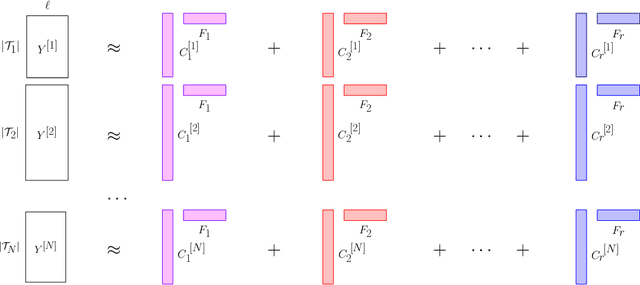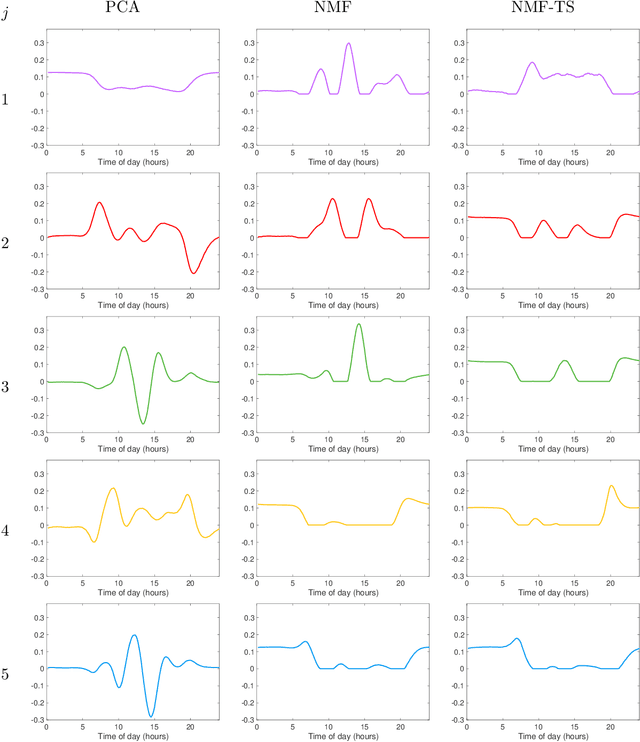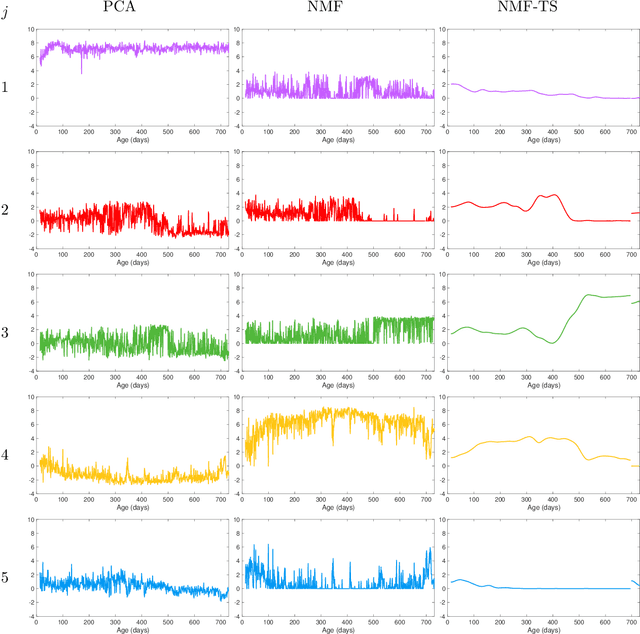David J. Heeger
Contrastive Self-Supervised Learning As Neural Manifold Packing
Jun 16, 2025Abstract:Contrastive self-supervised learning based on point-wise comparisons has been widely studied for vision tasks. In the visual cortex of the brain, neuronal responses to distinct stimulus classes are organized into geometric structures known as neural manifolds. Accurate classification of stimuli can be achieved by effectively separating these manifolds, akin to solving a packing problem. We introduce Contrastive Learning As Manifold Packing (CLAMP), a self-supervised framework that recasts representation learning as a manifold packing problem. CLAMP introduces a loss function inspired by the potential energy of short-range repulsive particle systems, such as those encountered in the physics of simple liquids and jammed packings. In this framework, each class consists of sub-manifolds embedding multiple augmented views of a single image. The sizes and positions of the sub-manifolds are dynamically optimized by following the gradient of a packing loss. This approach yields interpretable dynamics in the embedding space that parallel jamming physics, and introduces geometrically meaningful hyperparameters within the loss function. Under the standard linear evaluation protocol, which freezes the backbone and trains only a linear classifier, CLAMP achieves competitive performance with state-of-the-art self-supervised models. Furthermore, our analysis reveals that neural manifolds corresponding to different categories emerge naturally and are effectively separated in the learned representation space, highlighting the potential of CLAMP to bridge insights from physics, neural science, and machine learning.
Unconditional stability of a recurrent neural circuit implementing divisive normalization
Sep 27, 2024Abstract:Stability in recurrent neural models poses a significant challenge, particularly in developing biologically plausible neurodynamical models that can be seamlessly trained. Traditional cortical circuit models are notoriously difficult to train due to expansive nonlinearities in the dynamical system, leading to an optimization problem with nonlinear stability constraints that are difficult to impose. Conversely, recurrent neural networks (RNNs) excel in tasks involving sequential data but lack biological plausibility and interpretability. In this work, we address these challenges by linking dynamic divisive normalization (DN) to the stability of ORGaNICs, a biologically plausible recurrent cortical circuit model that dynamically achieves DN and has been shown to simulate a wide range of neurophysiological phenomena. By using the indirect method of Lyapunov, we prove the remarkable property of unconditional local stability for an arbitrary-dimensional ORGaNICs circuit when the recurrent weight matrix is the identity. We thus connect ORGaNICs to a system of coupled damped harmonic oscillators, which enables us to derive the circuit's energy function, providing a normative principle of what the circuit, and individual neurons, aim to accomplish. Further, for a generic recurrent weight matrix, we prove the stability of the 2D model and demonstrate empirically that stability holds in higher dimensions. Finally, we show that ORGaNICs can be trained by backpropagation through time without gradient clipping/scaling, thanks to its intrinsic stability property and adaptive time constants, which address the problems of exploding, vanishing, and oscillating gradients. By evaluating the model's performance on RNN benchmarks, we find that ORGaNICs outperform alternative neurodynamical models on static image classification tasks and perform comparably to LSTMs on sequential tasks.
Statistical whitening of neural populations with gain-modulating interneurons
Jan 27, 2023Abstract:Statistical whitening transformations play a fundamental role in many computational systems, and may also play an important role in biological sensory systems. Individual neurons appear to rapidly and reversibly alter their input-output gains, approximately normalizing the variance of their responses. Populations of neurons appear to regulate their joint responses, reducing correlations between neural activities. It is natural to see whitening as the objective that guides these behaviors, but the mechanism for such joint changes is unknown, and direct adjustment of synaptic interactions would seem to be both too slow, and insufficiently reversible. Motivated by the extensive neuroscience literature on rapid gain modulation, we propose a recurrent network architecture in which joint whitening is achieved through modulation of gains within the circuit. Specifically, we derive an online statistical whitening algorithm that regulates the joint second-order statistics of a multi-dimensional input by adjusting the marginal variances of an overcomplete set of interneuron projections. The gains of these interneurons are adjusted individually, using only local signals, and feed back onto the primary neurons. The network converges to a state in which the responses of the primary neurons are whitened. We demonstrate through simulations that the behavior of the network is robust to poor conditioning or noise when the gains are sign-constrained, and can be generalized to achieve a form of local whitening in convolutional populations, such as those found throughout the visual or auditory system.
Epistemic AI platform accelerates innovation by connecting biomedical knowledge
Jan 30, 2022

Abstract:Epistemic AI accelerates biomedical discovery by finding hidden connections in the network of biomedical knowledge. The Epistemic AI web-based software platform embodies the concept of knowledge mapping, an interactive process that relies on a knowledge graph in combination with natural language processing (NLP), information retrieval, relevance feedback, and network analysis. Knowledge mapping reduces information overload, prevents costly mistakes, and minimizes missed opportunities in the research process. The platform combines state-of-the-art methods for information extraction with machine learning, artificial intelligence and network analysis. Starting from a single biological entity, such as a gene or disease, users may: a) construct a map of connections to that entity, b) map an entire domain of interest, and c) gain insight into large biological networks of knowledge. Knowledge maps provide clarity and organization, simplifying the day-to-day research processes.
Time-Series Analysis via Low-Rank Matrix Factorization Applied to Infant-Sleep Data
Apr 10, 2019



Abstract:We propose a nonparametric model for time series with missing data based on low-rank matrix factorization. The model expresses each instance in a set of time series as a linear combination of a small number of shared basis functions. Constraining the functions and the corresponding coefficients to be nonnegative yields an interpretable low-dimensional representation of the data. A time-smoothing regularization term ensures that the model captures meaningful trends in the data, instead of overfitting short-term fluctuations. The low-dimensional representation makes it possible to detect outliers and cluster the time series according to the interpretable features extracted by the model, and also to perform forecasting via kernel regression. We apply our methodology to a large real-world dataset of infant-sleep data gathered by caregivers with a mobile-phone app. Our analysis automatically extracts daily-sleep patterns consistent with the existing literature. This allows us to compute sleep-development trends for the cohort, which characterize the emergence of circadian sleep and different napping habits. We apply our methodology to detect anomalous individuals, to cluster the cohort into groups with different sleeping tendencies, and to obtain improved predictions of future sleep behavior.
ORGaNICs: A Theory of Working Memory in Brains and Machines
May 25, 2018



Abstract:Working memory is a cognitive process that is responsible for temporarily holding and manipulating information. Most of the empirical neuroscience research on working memory has focused on measuring sustained activity in prefrontal cortex (PFC) and/or parietal cortex during simple delayed-response tasks, and most of the models of working memory have been based on neural integrators. But working memory means much more than just holding a piece of information online. We describe a new theory of working memory, based on a recurrent neural circuit that we call ORGaNICs (Oscillatory Recurrent GAted Neural Integrator Circuits). ORGaNICs are a variety of Long Short Term Memory units (LSTMs), imported from machine learning and artificial intelligence. ORGaNICs can be used to explain the complex dynamics of delay-period activity in prefrontal cortex (PFC) during a working memory task. The theory is analytically tractable so that we can characterize the dynamics, and the theory provides a means for reading out information from the dynamically varying responses at any point in time, in spite of the complex dynamics. ORGaNICs can be implemented with a biophysical (electrical circuit) model of pyramidal cells, combined with shunting inhibition via a thalamocortical loop. Although introduced as a computational theory of working memory, ORGaNICs are also applicable to models of sensory processing, motor preparation and motor control. ORGaNICs offer computational advantages compared to other varieties of LSTMs that are commonly used in AI applications. Consequently, ORGaNICs are a framework for canonical computation in brains and machines.
 Add to Chrome
Add to Chrome Add to Firefox
Add to Firefox Add to Edge
Add to Edge